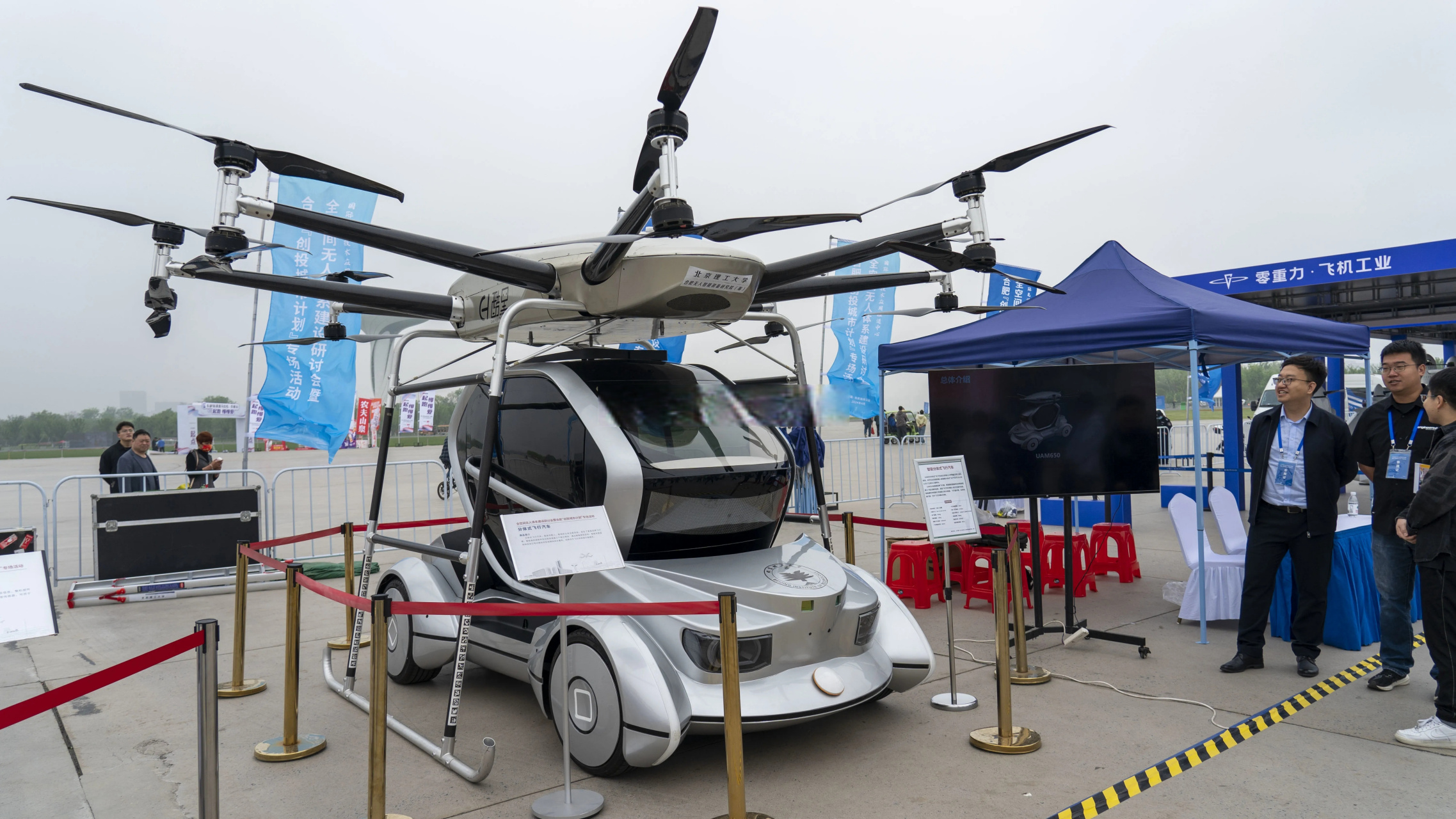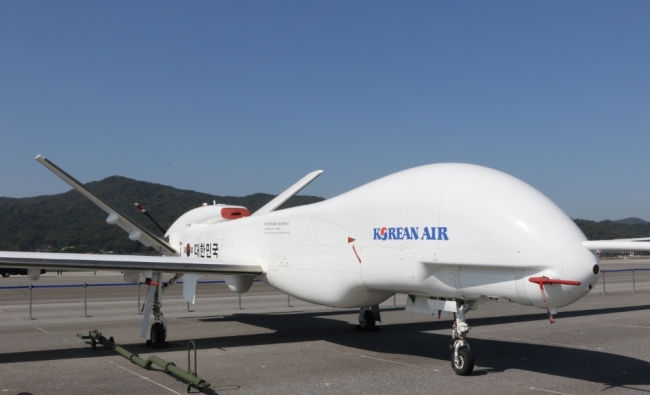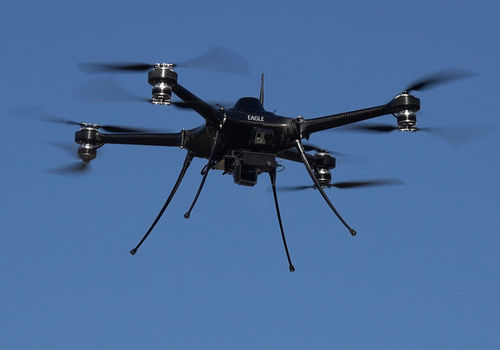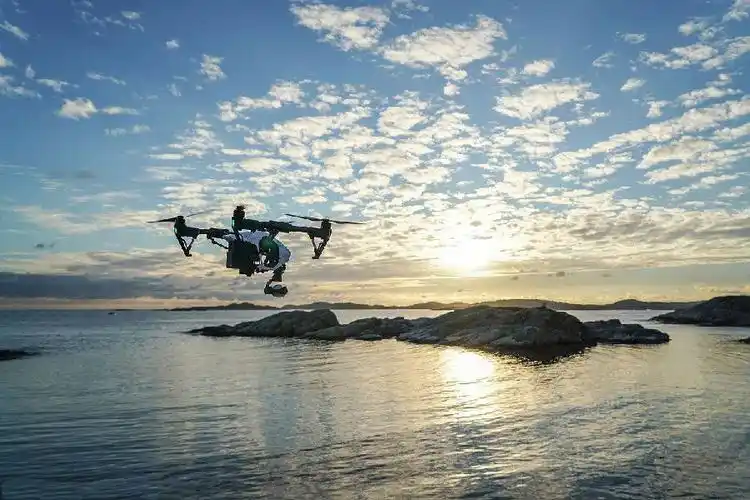
As an unmanned aerial vehicle operated by radio remote control equipment and self-contained program control devices, the market size of drones has continued to expand in recent years. From a global perspective, its application areas are constantly expanding, gradually extending from military use to civilian use, such as agricultural crop protection, logistics distribution, geographic surveying, film and television aerial photography, etc., driving the rapid growth of the drone market.
In recent years, the drone market has continued to expand in size and application areas, gradually extending from military use to civilian use, such as agricultural crop protection, logistics distribution, geographic surveying, film and television aerial photography, etc., driving the rapid growth of the drone market.
01. Market size and growth trend
In the past few years, the global drone market has shown a rapid growth trend. In 2020, the global drone industry market size exceeded 22 billion US dollars, reaching 27.5 billion US dollars in 2021, an increase of 25% compared to 2019. According to the Forward Industry Research Institute, the global drone market size is estimated to be around 24 billion US dollars in 2023, with military drones accounting for 24.0% and civilian drones accounting for 76.0%. It is expected that by 2030, the global commercial drone market will reach a size of 583.51 billion US dollars. The Chinese drone market is also developing rapidly, with a market size of 55 billion yuan in 2017 and over 100 billion yuan in the first half of 2018. According to data from the Civil Aviation Administration of China, as of the end of 2023, there are over 1.26 million drones in China, a year-on-year increase of about 32%. In 2023, the cumulative flight hours of civilian drones exceeded 23 million.
02. Competitive landscape
DJI holds an important position in the global drone market. According to Drone Industry Insight, a global drone market research firm, DJI Innovation ranks first among the top five civilian drone companies in 2023. DJI monopolizes approximately 70% -80% of the global commercial drone market.
03. Policy Environment
Governments around the world are increasingly improving their regulatory policies for drones. While regulating drone flight safety and ensuring airspace management order, they are also gradually opening up the low altitude field, creating favorable conditions for the commercial application of drones. The Civil Aviation Administration of China has approved the establishment of 17 civil unmanned aerial vehicle test zones and 3 test bases, covering scenarios such as cities, islands, regional logistics, and comprehensive application expansion.
The industrial scale continues to expand:
With the continuous advancement of technology and the continuous expansion of application fields, the size of China's drone market is expected to further grow. It is expected that by 2030, the scale of China's drone market is expected to exceed trillions, becoming the world's largest drone market.
Technological innovation continues to advance
Artificial intelligence, the Internet of Things, big data and other technologies will be deeply integrated with drone technology, promoting the development of drones towards intelligence and autonomy. For example, through intelligent recognition technology, drones can automatically recognize target objects and perform corresponding operations; Utilizing IoT technology to achieve collaborative operations and data sharing among multiple drones.
Deepening and expanding application areas:
Drones will be applied in more fields, such as emergency rescue, environmental monitoring, urban management, etc. In emergency rescue, drones can quickly reach the disaster site for tasks such as personnel search and material delivery; In terms of environmental monitoring, real-time monitoring of environmental data such as atmosphere and water quality can provide support for environmental protection.
The development trend of industrial clusters is obvious:
Multiple cities have sparked a wave of drone research and development, such as Chengdu's goal of building China's first industrial drone city, with an average annual growth rate of over 20% in industrial output value; Shenzhen's drone companies are in a leading position in technological innovation; Beijing, Xi'an, Wuhan and other cities are also leveraging their respective scientific research advantages to promote the development of the drone industry. The future development of industrial clusters will further enhance the competitiveness of China's drone industry.
Low altitude economy drives development:
The low altitude economy, as an emerging industry, is rapidly developing, and drones are an important component of it. With the gradual opening up of the low altitude field and the support of relevant policies, drones will play a greater role in the low altitude economy, driving the coordinated development of related industries. The development of fields such as aviation logistics and air tourism will bring new opportunities to the drone market.
Industry standards and regulations are gradually improving:
To ensure the healthy development of the drone industry, relevant departments will accelerate the formulation and improvement of industry standards and regulations for drones, including technical standards, safety standards, flight management norms, etc., to improve product quality and safety, and promote the standardized development of the market.
● Policy support:
Low altitude economy included in strategic emerging industries: By the end of 2023, low altitude economy will be included in the national strategic emerging industries. In 2024, "low altitude economy" will be included in the government work report for the first time. Many local governments have introduced a series of supportive policies, such as financial support for drone companies' technology research and development, innovation project incubation, talent introduction, etc., providing strong impetus for the development of the drone industry. The regulatory standard system is constantly improving: In recent years, China has issued multiple policies and regulations to encourage, support, and regulate the development of the drone industry, such as the "Implementation Plan for Innovative Applications of General Aviation Equipment (2024-2030)" and the "Interim Regulations on Flight Management of Unmanned Aerial Vehicles", which clarify the management norms and development direction of drones, providing strong guarantees for the safe operation and market development of drones.
Market demand growth
The application scenarios continue to expand: the application of drones in multiple fields continues to deepen and expand, and market demand is growing rapidly. Taking the agricultural field as an example, according to relevant data, the number of agricultural crop protection drones in China has increased from 12000 in 2017 to over 100000 in 2023, with an annual operating area of over 1 billion acres, and is still growing at a high rate. In the logistics field, logistics giants such as JD.com and SF Express have increased their research and application efforts in drone logistics. It is expected that by 2025, the market size of drone logistics will exceed 10 billion yuan. The consumer market has enormous potential: the demand for consumer grade drones is also increasingly strong. With consumers' love for entertainment methods such as aerial photography, the sales of consumer grade drones are rising year by year. In 2023, the market size of consumer grade drones in China reached around 15 billion yuan, a year-on-year increase of about 20%, and is expected to maintain a growth rate of 15% -20% in the coming years.
Technological progress drives progress
The level of intelligence and automation has been continuously improved with the integration of technologies such as artificial intelligence and big data. For example, current drones can achieve autonomous obstacle avoidance, automatic tracking, target recognition and other functions through intelligent algorithms, greatly improving usage efficiency and safety, reducing operational barriers, and enabling more users to use drones for various applications.
Enhanced endurance and payload capacity: The advancement of battery technology and the upgrade of power systems have significantly improved the endurance and payload capacity of drones. It is predicted that the drone power system market will steadily grow from 2024 to 2029, exceeding $2 billion. The application of some new battery technologies, such as solid-state batteries and lithium sulfur batteries, is expected to further extend the endurance of drones, enabling them to undertake more complex and challenging tasks
Optimization of communication and navigation technology: The development of communication technology enables drones to maintain stable signal transmission over longer distances, such as the application of 5G technology, which improves data transmission speed and reliability. At the same time, the improvement of navigation technology has enhanced the positioning accuracy and flight stability of unmanned aerial vehicles, reduced flight deviation, and improved the accuracy of task execution
● Industrial agglomeration development
The industrial chain is becoming increasingly perfect: the drone industry chain covers multiple links such as research and development, manufacturing, market operation, comprehensive support, and extended services, and the coordination and cooperation between each link are becoming increasingly close. At present, China has formed a number of highly competitive drone industry clusters, such as Shenzhen, Chengdu, Zhuhai and other places, gathering a large number of drone enterprises, research institutions and related service providers, forming a good industrial ecology, reducing the operating costs of enterprises, and improving the overall efficiency of the industry.
The collaborative innovation effect is significant: industrial agglomeration promotes cooperation and exchange among enterprises, universities, and research institutions, accelerating technology research and development and achievement transformation. For example, some universities and research institutions have collaborated with enterprises to conduct research on key technologies for drones, jointly overcoming multiple technical challenges and promoting technological progress and product upgrades in the drone industry.
● Increased demand for talent
Rich and diverse job opportunities: The rapid development of the drone industry has given rise to a large number of job opportunities, covering multiple fields such as drone pilots, flight control algorithm engineers, hardware research and development engineers, operations management engineers, and after-sales service engineers. According to incomplete statistics, the number of drone related professionals in China has exceeded 500000, with an annual growth rate of around 20%.
The talent cultivation system is gradually improving: some provinces and cities have introduced talent policies to support the development of low altitude economy, and universities are constantly strengthening the construction of drone related majors and talent cultivation efforts. For example, Shandong Information Vocational and Technical College has opened majors such as drone application technology and drone surveying technology, providing a large number of high-quality skilled talents for the drone industry. In 2024, the graduates of the drone application technology major at the university are in short supply, and the professional matching rate remains above 80%.
● Regulatory and supervisory aspects
Lack of higher-level laws: In the field of unmanned aerial vehicles, there is a lack of highly comprehensive and universally applicable higher-level laws such as the Constitution and laws, which leads to various departments and regions handling problems according to their own standards and regulations, resulting in a fragmented and disorderly legal system. This results in a vague division of responsibilities for the production, use, and supervision of drones, such as unclear regulatory responsibilities in aviation, transportation, public security, and other fields, which can easily lead to regulatory gaps or overlaps.
Imperfect regulatory system: unclear division of responsibilities among regulatory departments, existence of regulatory blind spots or cross supervision. The lack of unified regulatory standards, such as aviation departments focusing on flight safety and public security departments focusing on privacy protection, has led to practical operational difficulties. The regulatory measures are single, mostly post supervision, which cannot achieve pre prevention and in-process monitoring. And the regulatory force is insufficient, making it difficult to comprehensively and effectively regulate the numerous fields involved in drones.
Airworthiness certification and operating license issues: Unmanned aerial vehicle freight requires strict airworthiness certification and operating license, with complex certification procedures and strict standards. It is difficult and costly for operators to obtain certification, which restricts the rapid development of unmanned aerial vehicle freight business.
The management of flight airspace is complex: unmanned aerial vehicles and manned aerial vehicles share airspace, which is small in size and difficult to monitor with radar, posing challenges to air traffic management systems. Special airspace management rules need to be formulated to coordinate the interests of all parties, but currently the relevant rules are not yet perfect, which affects the large-scale application of drones.
● In terms of security and privacy
Flight safety risks: Drones are greatly affected by natural factors such as airflow and wind, have poor stability, are prone to losing control and crashing, pose a threat to personnel and property safety, and have higher risks when used in densely populated areas or complex environments. Meanwhile, mechanical failures and electronic component failures may also lead to flight accidents.
Data and privacy security issues: Drones collect and transmit large amounts of data, including personal images, location information, trade secrets, etc. There is a risk of leakage in the storage, transmission, and sharing of data. If obtained and utilized by criminals, it is easy to infringe on personal privacy and trade secrets, causing security issues.
Public safety hazards: Drones may be used for illegal activities such as terrorist attacks, espionage, etc., posing a threat to public safety. The drone "black flying" incidents in sensitive areas such as airports and military restricted zones seriously affect normal order and safety.
● Technical bottlenecks
Insufficient endurance: Currently, battery technology is unable to meet the long-term flight requirements of drones, limiting their application scope and task execution efficiency, and restricting long-distance and long-term operational tasks. Despite attempts to develop new battery materials and energy management systems, fundamental breakthroughs have not yet been achieved.
Limited payload capacity: Most drones have a small effective payload capacity and cannot carry large or heavy equipment, making it difficult to meet complex mission requirements such as large-scale material transportation and high-end scientific research equipment, which hinders the deep application of drones in some fields.
Communication and navigation technology needs improvement: In remote areas or signal interference environments, drone communication signals are unstable and prone to interruption, affecting control and data transmission. Insufficient navigation accuracy can lead to flight deviation and mission failure, and the reliability of existing navigation systems still needs to be improved in complex environments.
Limited level of intelligence: Although the intelligence level of drones continues to improve, they still cannot fully autonomously respond to complex environments and tasks, and there are shortcomings in autonomous decision-making, target recognition, path planning, and other aspects. When multiple machines collaborate, the formation control, information sharing, and collaborative decision-making technologies are not mature enough, which limits the development of cluster applications.
In terms of market competition
Intense competition: The drone market has numerous participants and intense competition. Enterprises need to continuously invest resources in technology research and development, product innovation, and market promotion to enhance competitiveness, otherwise they may be eliminated by the market. Meanwhile, market competition leads to a decrease in prices, squeezing the profit margins of enterprises.
Profit space compression: Market competition reduces product prices, while raw material and component costs increase, further affecting the profitability of enterprises and hindering their sustainable development and technological innovation. This may lead to some enterprises reducing their R&D investment and affecting the speed of industry technological progress.
In terms of talent shortage
The drone industry is developing rapidly and there is a strong demand for professional talents, but currently there is a shortage of talent supply. There is a large shortage of professional talents such as pilots, technical R&D personnel, and maintenance engineers, which restricts the speed and quality of industry development. The establishment of relevant majors and talent cultivation models in universities cannot meet the needs of rapid industry development, and the speed of talent cultivation lags behind the growth of market demand.
● In terms of raw material supply chain
Price fluctuation risk: Key raw materials such as carbon fiber, light metals, and electronic components required for drone manufacturing are affected by factors such as supply and demand, geopolitics, and natural disasters, resulting in significant price fluctuations that directly affect manufacturers' production costs and profits.
Supply shortage risk: The demand for raw materials in the drone industry continues to increase, and some key raw materials may experience supply shortages, such as carbon fiber supply, which has been tight and prices have risen, affecting the production schedule and cost of drones.
Quality problem risk: Drone manufacturers have high requirements for raw material quality, but some suppliers do not have sufficient quality control, resulting in substandard raw material quality and affecting the production quality and safety of drones.
Transportation interruption risk: Drone manufacturers need to purchase raw materials from all over the world, and the transportation process involves multiple links, which poses a risk of transportation interruption. For example, maritime transportation may be affected by pirate attacks, severe weather, etc., which may result in the inability to deliver raw materials on time.
Tariff risk: The drone industry involves international trade, and raw materials may be affected by import tariffs. Increasing tariffs will increase the cost of raw material procurement, thereby affecting product prices and competitiveness.
According to a report by Huirui Consulting, the global consumer drone market is expected to reach $3.745 billion in 2023 and is projected to grow at a compound annual growth rate of 21.25% to $21.212 billion by 2030. In 2023, the market size of consumer grade drones in China will account for about 71.48% of the global market, or approximately 2.676 billion US dollars.
In terms of growth rate, the scale of China's civilian drone industry has grown rapidly from 2018 to 2023. In 2018, the market size of China's consumer drone market was 5.12 billion yuan, and by 2023, the scale of China's civilian drone industry has exceeded 120 billion yuan, with a relatively large proportion of consumer drones.
● Growth factors
Technological progress drives the continuous development of battery technology, flight control systems, obstacle avoidance technology, etc., which continuously improves the performance of drones, such as extended endurance, improved shooting quality, and easier operation, attracting more consumers to purchase.
Application scenario expansion: The application scenarios of consumer grade drones are constantly enriching. In addition to traditional aerial photography and entertainment flights, they are also widely used in outdoor exploration, tourism recording, wedding celebrations and other scenarios, and the market demand continues to increase.
Policy support and regulatory improvement: Governments around the world are continuously increasing their support for the drone industry, while also improving relevant regulatory policies, regulating market order, providing guarantees for the healthy development of the consumer drone market, encouraging more enterprises to enter the market, and promoting market expansion.
Price reduction and popularization: With the maturity of technology and the intensification of market competition, the price of consumer grade drones has gradually decreased, making it affordable for more consumers and further promoting the popularization and growth of the market.
Improved consumer awareness: With the increasing exposure of drones in various media and events, consumers' awareness and acceptance of drones continue to rise, and more and more people are beginning to understand and pay attention to drone products, stimulating potential market demand.
● Restrictive factors
Market saturation is gradually increasing: With the continuous development of the consumer drone market, market saturation will gradually increase. When most potential consumers have already purchased drone products, the growth rate of market demand may gradually slow down.
Privacy and security issues: Drones may be involved in privacy violations and security risks during flight, such as unauthorized filming of others' privacy, interference with aviation safety, etc. This may lead to stricter regulatory policies by the government, limiting the scope of drone use and flight areas, thereby having a certain impact on market growth.
Intensifying competition and shrinking profit margins: The intensification of market competition may lead to a compression of a company's profit margins, and some small businesses may face survival difficulties, thereby affecting the development momentum and innovation capabilities of the entire market.
The substitution risk of emerging technologies: With the continuous development of technology, there may be some emerging technologies or products that pose a substitution threat to the consumer drone market, such as satellite remote sensing technology, smart balloons, etc. These new technologies or products may replace the functions of drones in certain application scenarios, thereby affecting the demand of the drone market.




